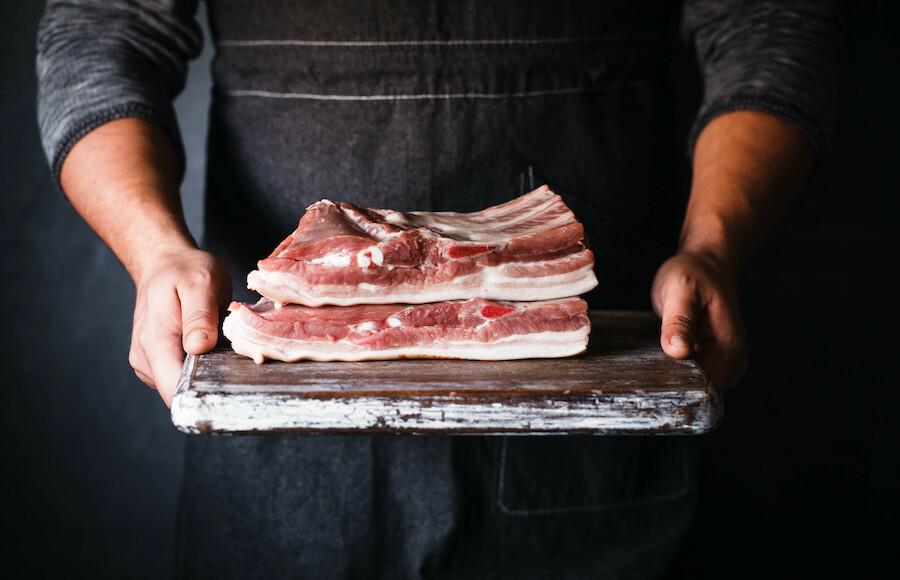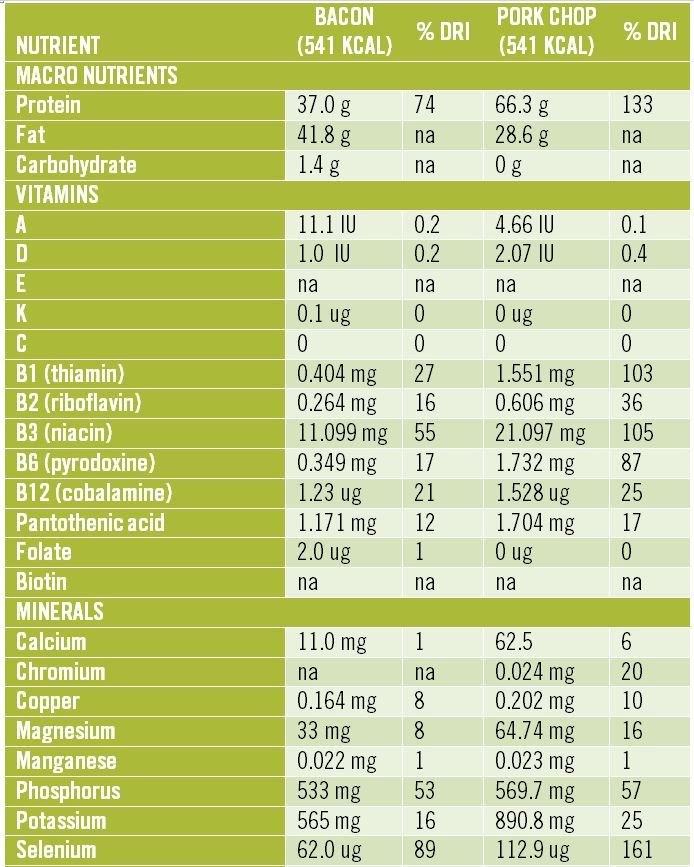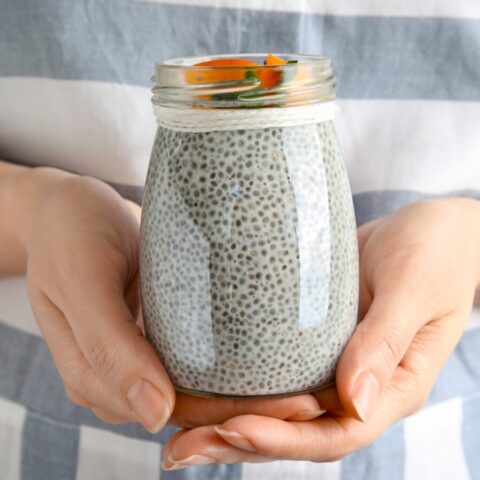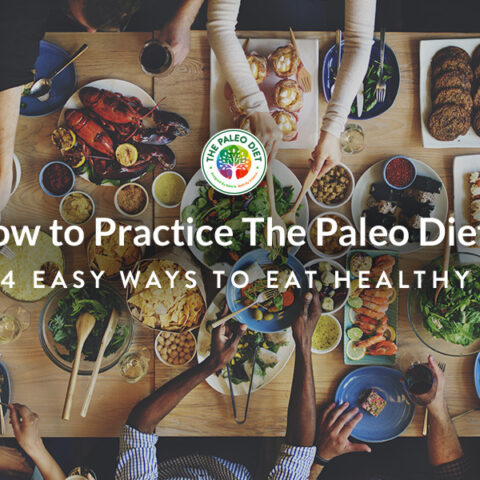Is Bacon Paleo?

Over the past few years, the bacon craze has surged in the Paleo community. While bacon is very tasty; unfortunately, bacon is not Paleo.
Bacon is high in added salt, nitrates, and other unhealthy chemicals that are injected into the meat to help preserve it. Plus, the bacon you find at the grocery store often come from feedlot farms, which contributes to another host of problems.
So, what’s the alternative to bacon? Unprocessed pork bellies are a great place to start. You can also enjoy pasture-raised pork chops, which are much lower in sodium and higher in nutrients.
Read on to learn how bacon differs from free-range pork, and why it matters.
What’s the difference between bacon and pork chops?
Accordingly, let’s contrast the nutritional differences between bacon (a processed meat) and pasture produced pork chops (a fresh meat). Dietary analysis software represents one of the most useful tools you can have to analyze and appreciate how various foods differ in macro (protein, fat, carbohydrate) and micro (vitamins and minerals) nutrients. My personal favorite is Nutritionist Pro™ and I have been using various versions of it for more than a decade.1 This software is a bit pricey, but if you are immersed in diet and nutrition, it is well worth the cost. The data featured in the table below contrasting bacon and pork chops was derived from this software.
Take some time and look this table over if you have any doubts about whether you should eat bacon or pork chops for breakfast – at least from a nutritional point of view. I have done this analysis using a 100 gram (a little less than ¼ pound) portion of bacon which amounts to 541 kilocalories (kcal) and an identical 541 kcal portion of pork chops. For each nutrient I also provided the dietary reference intake (DRI) which represents U.S. governmental daily recommendations for each nutrient.

One of the first data points that should grab your attention is the vastly differing protein to fat ratios between bacon and pork chops. On an equivalent caloric basis, the chops contain 79.2% more protein than bacon and 31.6% less total fat. This basic statistic has huge nutritional ramifications because lean protein is vastly superior to fat in regards to its vitamin and mineral concentrations. Meaning, meat is much more nutritionally dense for virtually all micronutrients (vitamins and minerals) than fat.
This concept immediately jumps out from the numbers you can see in this table. An equivalent caloric serving of pork chops compared to bacon contains 284% more vitamin B1 (thiamin), 130% more B2 (riboflavin), 90% more vitamin B3 (niacin), 396% more vitamin B6 (pyridoxine), 24% more vitamin B12, and 46% more pantothenic acid. For minerals, pork chops compared to bacon, have 468% more calcium, 23% more copper, 96% more magnesium, 4.6% more manganese, 6.9% more phosphorus, 57% more potassium, 82% more selenium, and 58% more zinc. Need I say more? Pork chops literally blow away bacon in terms of their nutritional superiority. In turn, the higher vitamin, mineral and protein concentrations of pork chops compared to bacon ultimately have multiple and far reaching health promoting effects.2-7
Take a look at the sodium difference between bacon and pork chops. Bacon has a whopping 2310 mg of sodium per 100 grams, whereas pork chops contain only 142 grams of sodium. This enormous difference in sodium (93% lower for chops compared to bacon) has significant physiological and health consequences. You don’t have to look very far to see that bacon’s super high salt concentration has multiple adverse health effects, including erectile dysfunction.
How is bacon made?
Before I leave bacon, let’s take a look at how bacon is typically produced. Virtually all of the bacon you buy at the supermarket comes from pigs that are raised indoors for most of their lives, predominantly fed grains, synthetic amino acids, vitamins and given hormones and antibiotics.8-10 Bacon is by no means a natural meat, but rather is selectively manufactured from the fat tissue butchered directly above a pig’s abdominal cavity. These slabs of tissue contain huge amounts of fat, little muscle (see table above) and are known in the industry as “pork bellies.”
After a pig’s slaughter, pork bellies (slabs) are typically injected with 1) salt, 2) nitrite or nitrate, 3) sodium erythorbate or sodium ascorbate and 4) phosphates.11 So, where once outside of a pig’s abdominal tissue you previously had natural fat and a miniscule amount of muscle, you now have a totally adulterated product containing salt, nitrites or nitrates, sodium erythrobate or ascorbate and phosphates – to say nothing about the selective butchering process which leaves the predominant muscle carcass behind. After pork bellies/slabs are injected, they are usually mechanically massaged, cooked/smoked and chilled and then sliced into the bacon strips we all recognize.11You don’t have to be a food scientist to know that all of these manufacturing procedures yield a product far different from the animal’s natural meat and fat content.
A final way of comparing the artificial and unhealthful characteristics of bacon to free range pork meat is by contrasting the nutritional characteristics of feed lot raised pigs (which are used to produce bacon) to free ranging wild boars.12-14 Although you may think that wild boars are completely unrelated to domesticated pigs, actually they are exactly the same genus and species – except that one lives under the hand of humans whereas the other lives freely.
Why free-range pork is better
Wild pigs/boars forage freely and eat mainly vegetables, small game, and eggs.15 Consequently, for humans eating wild boar meat, we may benefit by consuming the superior nutritional characteristics of wild pigs including leaner meat,14 greater beneficial polyunsaturated fats12 and higher vitamin E.13
Because pigs are monogastric animals (single stomach), they have the ability to convert vegetable and plant 18 carbon fatty acids (ALA) to the 20 and 22 carbon fatty acids (EPA and DHA) which reduce inflammation, reduce cardiovascular disease and promote good health for us all when we eat pork. Free-ranging pork contains higher concentrations of these beneficial fatty acids than are found in their feed lot produced counterparts.16-18
References
1. Nutritionist Pro Software. Axxya Systems, Stafford, TX //www.nutritionistpro.com
2. Cordain L. The nutritional characteristics of a contemporary diet based upon Paleolithic food groups. J Am Neutraceut Assoc 2002; 5:15-24.
3. Cordain L, Eaton SB, Brand Miller J, Mann N, Hill K. The paradoxical nature of hunter-gatherer diets: Meat based, yet non-atherogenic. Eur J Clin Nutr 2002;56 (suppl 1):S42-S52.
4. Cordain L, Eades MR, Eades MD. (2003). Hyperinsulinemic diseases of civilization: more than just syndrome X. Comp Biochem Physiol Part A:136:95-112.
5. O’Keefe J.H., Cordain L. Cardiovascular disease as a result of a diet and lifestyle at odds with our Paleolithic genome: how to become a 21st century hunter-gatherer. Mayo Clin Proc 2004;79:101-108.
6. Cordain L, Eaton SB, Sebastian A, Mann N, Lindeberg S, Watkins BA, O’Keefe JH, Brand-Miller J. Origins and evolution of the western diet: Health implications for the 21st century. Am J Clin Nutr 2005;81:341-54.
7. Carrera-Bastos P, Fontes Villalba M, O’Keefe JH, Lindeberg S, Cordain L. The western diet and lifestyle and diseases of civilization. Res Rep Clin Cardiol 2011; 2: 215-235.
8. Millet S, Raes K, Van den Broeck W, De Smet S, Janssens GP. Performance and meat quality of organically versus conventionally fed and housed pigs from weaning till slaughtering. Meat Sci. 2005 Feb;69(2):335-41
9. Hansen LL, Claudi-Magnussen C, Jensen SK, Andersen HJ.Effect of organic pig production systems on performance and meat quality. Meat Sci. 2006 Dec;74(4):605-15.
10. Edwards SA. Product quality attributes associated with outdoor pig production. Livestock Prod Sci 2005;94:5-14.
11. //www.nassaufoods.com/index.php?content=basicmanufacturingofbacon
12. Skewes O, Morales R, Mendoza N, Smulders FJ, Paulsen P. Carcass and meat quality traits of wild boar (Sus scrofa s. L.) with 2n=36 karyotype compared to those of phenotypically similar crossbreeds (2n=37 and 2n=38) raised under the same farming conditions 2 Fatty acid profile and cholesterol. Meat Sci. 2009 Oct;83(2):195-200.
13. Quaresma MA, Alves SP, Trigo-Rodrigues I, Pereira-Silva R, Santos N, Lemos JP, Barreto AS, Bessa RJ. Nutritional evaluation of the lipid fraction of feral wild boar (Sus scrofa scrofa) meat. Meat Sci. 2011 Dec;89(4):457-61
14. Sales J, Kotrba R. Meat from wild boar (Sus scrofa L.): a review. Meat Sci. 2013 Jun;94(2):187-201
15. Laurent S, Timonthy JR. Diet of wild boar Sus scrofa in Western Europe with particular reference to consumption of agricultural crops. Mammal Review, 2003;33(1): 43-56.
16. Romans JR, Wulf DM, Johnson RC, Libal GW, Costello WJ.Effects of ground flaxseed in swine diets on pig performance and on physical and sensory characteristics and omega-3 fatty acid content of pork: II. Duration of 15% dietary flaxseed. J Anim Sci. 1995 Jul;73(7):1987-99
17. Averette Gatlin L, See MT, Hansen JA, Sutton D, Odle J. The effects of dietary fat sources, levels, and feeding intervals on pork fatty acid composition.J Anim Sci. 2002 Jun;80(6):1606-15
18. Martínez-Ramírez HR, Cant JP, Shoveller AK, Atkinson JL, de Lange CF. Whole-body retention of α-linolenic acid and its apparent conversion to other n-3 PUFA in growing pigs are reduced with the duration of feeding α-linolenic acid. Br J Nutr. 2014 Apr 28;111(8):1382-93




